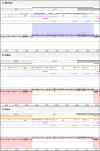Congenital hypopituitarism in two brothers with a duplication of the 'acrogigantism gene' GPR101: clinical findings and review of the literature
- PMID: 33184694
- PMCID: PMC7966638
- DOI: 10.1007/s11102-020-01101-8
Congenital hypopituitarism in two brothers with a duplication of the 'acrogigantism gene' GPR101: clinical findings and review of the literature
Abstract
Purpose: Congenital hypopituitarism (CH) can cause significant morbidity or even mortality. In the majority of patients, the etiology of CH is unknown. Understanding the etiology of CH is important for anticipation of clinical problems and for genetic counselling. Our previous studies showed that only a small proportion of cases have mutations in the known 'CH genes'. In the current project, we present the results of SNP array based copy number variant analysis in a family with unexplained congenital hypopituitarism.
Methods: DNA samples of two affected brothers with idiopathic CH and their mother were simultaneously analyzed by SNP arrays for copy number variant analysis and Whole Exome Sequencing (WES) for mutation screening. DNA of the father was not available.
Results: We found a 6 Mb duplication including GPR101 and SOX3 on the X-chromosome (Xq26.2-q27.1) in the two siblings and their mother, leading to 2 copies of this region in the affected boys and 3 copies in the mother. Duplications of GPR101 are associated with X-linked acrogigantism (the phenotypic 'opposite' of the affected brothers), whereas alterations in SOX3 are associated with X-linked hypopituitarism.
Conclusion: In our patients with hypopituitarism we found a 6 Mb duplication which includes GPR101, a gene associated with X- linked gigantism, and SOX3, a gene involved in early pituitary organogenesis that is associated with variable degrees of hypopituitarism. Our findings show that in duplications containing both GPR101 and SOX3, the growth hormone deficiency phenotype is dominant. This suggests that, if GPR101 is duplicated, it might not be expressed phenotypically when early patterning of the embryonic pituitary is affected due to SOX3 duplication. These results, together with the review of the literature, shed a new light on the role of GPR101 and SOX3 in pituitary function.
Keywords: Acromegaly; G-protein coupled receptor; Gene duplication; Pituitary gland; Transcription factors.
Figures


Similar articles
-
Array comparative genomic hybridisation analysis of boys with X linked hypopituitarism identifies a 3.9 Mb duplicated critical region at Xq27 containing SOX3.J Med Genet. 2004 Sep;41(9):669-78. doi: 10.1136/jmg.2003.016949. J Med Genet. 2004. PMID: 15342697 Free PMC article.
-
Germline or somatic GPR101 duplication leads to X-linked acrogigantism: a clinico-pathological and genetic study.Acta Neuropathol Commun. 2016 Jun 1;4(1):56. doi: 10.1186/s40478-016-0328-1. Acta Neuropathol Commun. 2016. PMID: 27245663 Free PMC article.
-
Xq27.1 Duplication Encompassing SOX3: Variable Phenotype and Smallest Duplication Associated with Hypopituitarism to Date - A Large Case Series of Unrelated Patients and a Literature Review.Horm Res Paediatr. 2019;92(6):382-389. doi: 10.1159/000503784. Epub 2019 Nov 1. Horm Res Paediatr. 2019. PMID: 31678974 Review.
-
Mutations in GPR101 as a potential cause of X-linked acrogigantism and acromegaly.Prog Mol Biol Transl Sci. 2019;161:47-67. doi: 10.1016/bs.pmbts.2018.10.003. Epub 2018 Nov 23. Prog Mol Biol Transl Sci. 2019. PMID: 30711029 Review.
-
Gigantism: X-linked acrogigantism and GPR101 mutations.Growth Horm IGF Res. 2016 Oct-Dec;30-31:64-69. doi: 10.1016/j.ghir.2016.09.007. Epub 2016 Sep 29. Growth Horm IGF Res. 2016. PMID: 27743704 Review.
Cited by
-
Case Report: A Novel Point Mutation of SOX3 in a Subject With Growth Hormone Deficiency, Hypogonadotrophic Hypogonadism, and Borderline Intellectual Disability.Front Endocrinol (Lausanne). 2022 Feb 28;13:810375. doi: 10.3389/fendo.2022.810375. eCollection 2022. Front Endocrinol (Lausanne). 2022. PMID: 35295983 Free PMC article.
References
-
- Meazza C, et al. Metabolic parameters and adipokine profi le in growth hormone deficient (GHD) children before and after 12-month GH treatment. Horm Metab Res. 2013;45:1–5. - PubMed
-
- Youngblood JL, Coleman TF, Davis SW. Regulation of pituitary progenitor differentiation by beta-catenin. Endocrinology. 2018;159(9):3287–3305. - PubMed
-
- De Graaff L (2008) Genetic and non-genetic causes of isolated growth hormone deficiency and combined pituitary hormone deficiency: results of the HYPOPIT study
-
- Alatzoglou KS, et al. Isolated growth hormone deficiency (GHD) in childhood and adolescence: recent advances. Endocr Rev. 2014;35(3):376–432. - PubMed
Publication types
MeSH terms
Substances
LinkOut - more resources
Full Text Sources
Miscellaneous

